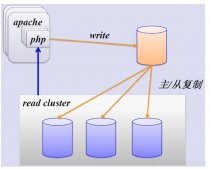MySQL 开发组于 2019 年 10 月 14 日 正式发布了 MySQL 8.0.18 GA 版本,带来了一些新特性和增强功能。其中最引人注目的莫过于多表连接查询支持 hash join 方式了。我们先来看看官方的描述:
MySQL 实现了用于内连接查询的 hash join 方式。例如,从 MySQL 8.0.18 开始以下查询可以使用 hash join 进行连接查询:
|
1
2
3
4
|
SELECT * FROM t1 JOIN t2 ON t1.c1=t2.c1; |
Hash join 不需要索引的支持。大多数情况下,hash join 比之前的 Block Nested-Loop 算法在没有索引时的等值连接更加高效。使用以下语句创建三张测试表:
|
1
2
3
|
CREATE TABLE t1 (c1 INT, c2 INT);CREATE TABLE t2 (c1 INT, c2 INT);CREATE TABLE t3 (c1 INT, c2 INT); |
使用EXPLAIN FORMAT=TREE命令可以看到执行计划中的 hash join,例如:
|
1
2
3
4
5
6
7
8
9
10
|
mysql> EXPLAIN FORMAT=TREE -> SELECT * -> FROM t1 -> JOIN t2 -> ON t1.c1=t2.c1\G*************************** 1. row ***************************EXPLAIN: -> Inner hash join (t2.c1 = t1.c1) (cost=0.70 rows=1) -> Table scan on t2 (cost=0.35 rows=1) -> Hash -> Table scan on t1 (cost=0.35 rows=1) |
必须使用 EXPLAIN 命令的 FORMAT=TREE 选项才能看到节点中的 hash join。另外,EXPLAIN ANALYZE命令也可以显示 hash join 的使用信息。这也是该版本新增的一个功能。
多个表之间使用等值连接的的查询也会进行这种优化。例如以下查询:
|
1
2
3
4
5
6
|
SELECT * FROM t1 JOIN t2 ON (t1.c1 = t2.c1 AND t1.c2 < t2.c2) JOIN t3 ON (t2.c1 = t3.c1); |
在以上示例中,任何其他非等值连接的条件将会在连接操作之后作为过滤器使用。可以通过EXPLAIN FORMAT=TREE命令的输出进行查看:
|
1
2
3
4
5
6
7
8
9
10
11
12
13
14
15
16
|
mysql> EXPLAIN FORMAT=TREE -> SELECT * -> FROM t1 -> JOIN t2 -> ON (t1.c1 = t2.c1 AND t1.c2 < t2.c2) -> JOIN t3 -> ON (t2.c1 = t3.c1)\G*************************** 1. row ***************************EXPLAIN: -> Inner hash join (t3.c1 = t1.c1) (cost=1.05 rows=1) -> Table scan on t3 (cost=0.35 rows=1) -> Hash -> Filter: (t1.c2 < t2.c2) (cost=0.70 rows=1) -> Inner hash join (t2.c1 = t1.c1) (cost=0.70 rows=1) -> Table scan on t2 (cost=0.35 rows=1) -> Hash -> Table scan on t1 (cost=0.35 rows=1) |
从以上输出同样可以看出,包含多个等值连接条件的查询也可以(会)使用多个 hash join 连接。
但是,如果任何连接语句(ON)中没有使用等值连接条件,将不会采用 hash join 连接方式。例如:
|
1
2
3
4
5
6
7
8
9
|
mysql> EXPLAIN FORMAT=TREE -> SELECT * -> FROM t1 -> JOIN t2 -> ON (t1.c1 = t2.c1) -> JOIN t3 -> ON (t2.c1 < t3.c1)\G*************************** 1. row ***************************EXPLAIN: <not executable by iterator executor> |
此时,将会采用性能更慢的 block nested loop 连接算法。这与 MySQL 8.0.18 之前版本中没有索引时的情况一样:
|
1
2
3
4
5
6
7
8
9
10
11
12
13
14
15
16
17
18
19
20
21
22
23
24
25
26
27
28
29
30
31
32
33
34
35
36
37
38
39
40
41
42
43
44
45
46
|
mysql> EXPLAIN -> SELECT * -> FROM t1 -> JOIN t2 -> ON (t1.c1 = t2.c1) -> JOIN t3 -> ON (t2.c1 < t3.c1)\G *************************** 1. row *************************** id: 1 select_type: SIMPLE table: t1 partitions: NULL type: ALLpossible_keys: NULL key: NULL key_len: NULL ref: NULL rows: 1 filtered: 100.00 Extra: NULL*************************** 2. row *************************** id: 1 select_type: SIMPLE table: t2 partitions: NULL type: ALLpossible_keys: NULL key: NULL key_len: NULL ref: NULL rows: 1 filtered: 100.00 Extra: Using where; Using join buffer (Block Nested Loop)*************************** 3. row *************************** id: 1 select_type: SIMPLE table: t3 partitions: NULL type: ALLpossible_keys: NULL key: NULL key_len: NULL ref: NULL rows: 1 filtered: 100.00 Extra: Using where; Using join buffer (Block Nested Loop) |
Hash join 连接同样适用于不指定查询条件时的笛卡尔积(Cartesian product),例如:
|
1
2
3
4
5
6
7
8
9
10
11
|
mysql> EXPLAIN FORMAT=TREE -> SELECT * -> FROM t1 -> JOIN t2 -> WHERE t1.c2 > 50\G*************************** 1. row ***************************EXPLAIN: -> Inner hash join (cost=0.70 rows=1) -> Table scan on t2 (cost=0.35 rows=1) -> Hash -> Filter: (t1.c2 > 50) (cost=0.35 rows=1) -> Table scan on t1 (cost=0.35 rows=1) |
默认配置时,MySQL 所有可能的情况下都会使用 hash join。同时提供了两种控制是否使用 hash join 的方法:
在全局或者会话级别设置服务器系统变量 optimizer_switch 中的 hash_join=on 或者 hash_join=off 选项。默认为 hash_join=on。
在语句级别为特定的连接指定优化器提示 HASH_JOIN 或者 NO_HASH_JOIN。
可以通过系统变量 join_buffer_size 控制 hash join 允许使用的内存数量;hash join 不会使用超过该变量设置的内存数量。如果 hash join 所需的内存超过该阈值,MySQL 将会在磁盘中执行操作。需要注意的是,如果 hash join 无法在内存中完成,并且打开的文件数量超过系统变量 open_files_limit 的值,连接操作可能会失败。为了解决这个问题,可以使用以下方法之一:
增加 join_buffer_size 的值,确保 hash join 可以在内存中完成。
增加 open_files_limit 的值。
接下来他们比较一下 hash join 和 block nested loop 的性能,首先分别为 t1、t2 和 t3 生成 1000000 条记录:
|
1
2
3
4
5
6
7
8
9
10
11
12
13
14
|
set join_buffer_size=2097152000;SET @@cte_max_recursion_depth = 99999999;INSERT INTO t1-- INSERT INTO t2-- INSERT INTO t3WITH RECURSIVE t AS ( SELECT 1 AS c1, 1 AS c2 UNION ALL SELECT t.c1 + 1, t.c1 * 2 FROM t WHERE t.c1 < 1000000)SELECT * FROM t; |
没有索引情况下的 hash join:
|
1
2
3
4
5
6
7
8
9
10
11
12
13
14
15
16
17
18
19
20
21
22
23
24
25
26
27
28
29
30
31
|
mysql> EXPLAIN ANALYZE -> SELECT COUNT(*) -> FROM t1 -> JOIN t2 -> ON (t1.c1 = t2.c1) -> JOIN t3 -> ON (t2.c1 = t3.c1)\G*************************** 1. row ***************************EXPLAIN: -> Aggregate: count(0) (actual time=22993.098..22993.099 rows=1 loops=1) -> Inner hash join (t3.c1 = t1.c1) (cost=9952535443663536.00 rows=9952435908880402) (actual time=14489.176..21737.032 rows=1000000 loops=1) -> Table scan on t3 (cost=0.00 rows=998412) (actual time=0.103..3973.892 rows=1000000 loops=1) -> Hash -> Inner hash join (t2.c1 = t1.c1) (cost=99682753413.67 rows=99682653660) (actual time=5663.592..12236.984 rows=1000000 loops=1) -> Table scan on t2 (cost=0.01 rows=998412) (actual time=0.067..3364.105 rows=1000000 loops=1) -> Hash -> Table scan on t1 (cost=100539.40 rows=998412) (actual time=0.133..3395.799 rows=1000000 loops=1)1 row in set (23.22 sec)mysql> SELECT COUNT(*) -> FROM t1 -> JOIN t2 -> ON (t1.c1 = t2.c1) -> JOIN t3 -> ON (t2.c1 = t3.c1);+----------+| COUNT(*) |+----------+| 1000000 |+----------+1 row in set (12.98 sec) |
实际运行花费了 12.98 秒。这个时候如果使用 block nested loop:
|
1
2
3
4
5
6
7
8
9
10
11
12
13
14
15
16
17
18
|
mysql> EXPLAIN FORMAT=TREE -> SELECT /*+ NO_HASH_JOIN(t1, t2, t3) */ COUNT(*) -> FROM t1 -> JOIN t2 -> ON (t1.c1 = t2.c1) -> JOIN t3 -> ON (t2.c1 = t3.c1)\G*************************** 1. row ***************************EXPLAIN: <not executable by iterator executor>1 row in set (0.00 sec)SELECT /*+ NO_HASH_JOIN(t1, t2, t3) */ COUNT(*) FROM t1 JOIN t2 ON (t1.c1 = t2.c1) JOIN t3 ON (t2.c1 = t3.c1); |
EXPLAIN 显示无法使用 hash join。查询跑了几十分钟也没有出结果,其中一个 CPU 使用率到了 100%;因为一直在执行嵌套循环(1000000 的 3 次方)。
再看有索引时的 block nested loop 方法,增加索引:
|
1
2
3
4
5
6
7
8
9
|
mysql> CREATE index idx1 ON t1(c1);Query OK, 0 rows affected (7.39 sec)Records: 0 Duplicates: 0 Warnings: 0mysql> CREATE index idx2 ON t2(c1);Query OK, 0 rows affected (6.77 sec)Records: 0 Duplicates: 0 Warnings: 0mysql> CREATE index idx3 ON t3(c1);Query OK, 0 rows affected (7.23 sec)Records: 0 Duplicates: 0 Warnings: 0 |
查看执行计划并运行相同的查询语句:
|
1
2
3
4
5
6
7
8
9
10
11
12
13
14
15
16
17
18
19
20
21
22
23
24
25
26
27
28
29
30
|
mysql> EXPLAIN ANALYZE -> SELECT COUNT(*) -> FROM t1 -> JOIN t2 -> ON (t1.c1 = t2.c1) -> JOIN t3 -> ON (t2.c1 = t3.c1)\G*************************** 1. row ***************************EXPLAIN: -> Aggregate: count(0) (actual time=47684.034..47684.035 rows=1 loops=1) -> Nested loop inner join (cost=2295573.22 rows=998412) (actual time=0.116..46363.599 rows=1000000 loops=1) -> Nested loop inner join (cost=1198056.31 rows=998412) (actual time=0.087..25788.696 rows=1000000 loops=1) -> Filter: (t1.c1 is not null) (cost=100539.40 rows=998412) (actual time=0.050..5557.847 rows=1000000 loops=1) -> Index scan on t1 using idx1 (cost=100539.40 rows=998412) (actual time=0.043..3253.769 rows=1000000 loops=1) -> Index lookup on t2 using idx2 (c1=t1.c1) (cost=1.00 rows=1) (actual time=0.012..0.015 rows=1 loops=1000000) -> Index lookup on t3 using idx3 (c1=t1.c1) (cost=1.00 rows=1) (actual time=0.012..0.015 rows=1 loops=1000000)1 row in set (47.68 sec)mysql> SELECT COUNT(*) -> FROM t1 -> JOIN t2 -> ON (t1.c1 = t2.c1) -> JOIN t3 -> ON (t2.c1 = t3.c1);+----------+| COUNT(*) |+----------+| 1000000 |+----------+1 row in set (19.56 sec) |
实际运行花费了 19.56 秒。所以在我们这个场景中的测试结果如下:
| Hash Join(无索引) | Block Nested Loop(无索引) | Block Nested Loop(有索引) |
|---|---|---|
| 12.98 s | 未返回 | 19.56 s |
再增加一个 Oracle 12c 中无索引时 hash join 结果:1.282 s。
再增加一个 PostgreSQL 11.5 中无索引时 hash join 结果:6.234 s。
再增加一个 SQL 2017 中无索引时 hash join 结果:5.207 s。
总结
以上所述是小编给大家介绍的MySQL 8.0 新特性之哈希连接(Hash Join),希望对大家有所帮助,如果大家有任何疑问请给我留言,小编会及时回复大家的。在此也非常感谢大家对服务器之家网站的支持!如果你觉得本文对你有帮助,欢迎转载,烦请注明出处,谢谢!
原文链接:https://blog.csdn.net/horses/article/details/102690076













